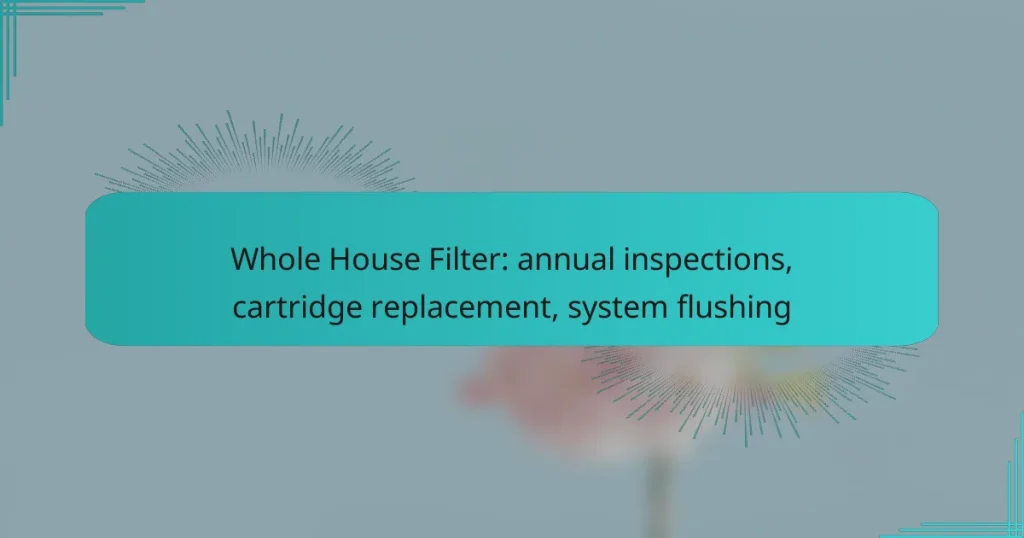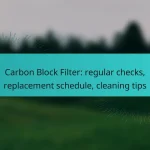Whole house filters are essential for homeowners in the UK, providing cleaner water throughout the home while enhancing the lifespan of appliances. To maintain optimal performance, these systems should undergo annual inspections, which help identify potential issues early on. Additionally, regular cartridge replacement is crucial for ensuring water quality and system efficiency, while flushing the system helps remove any accumulated contaminants.

What are the benefits of whole house filters in the UK?
Whole house filters provide significant advantages for homeowners in the UK by ensuring cleaner water throughout the entire home. These systems improve water quality, reduce contaminants, and can enhance the lifespan of household appliances.
Improved water quality
Whole house filters enhance water quality by removing impurities and sediments that can affect taste and clarity. This leads to better drinking water and a more pleasant experience for bathing and cooking. Regular maintenance, including annual inspections, ensures that the filter operates effectively over time.
Reduced contaminants
By filtering out harmful substances such as chlorine, lead, and bacteria, whole house filters significantly reduce health risks associated with contaminated water. Homeowners should consider replacing cartridges every six months to a year, depending on usage and water quality, to maintain optimal performance.
Enhanced appliance lifespan
Whole house filters can prolong the lifespan of appliances like dishwashers and washing machines by preventing scale buildup and corrosion caused by hard water and contaminants. Flushing the system periodically helps maintain efficiency, ensuring that appliances run smoothly and last longer. Regular checks can help identify any issues before they become costly repairs.
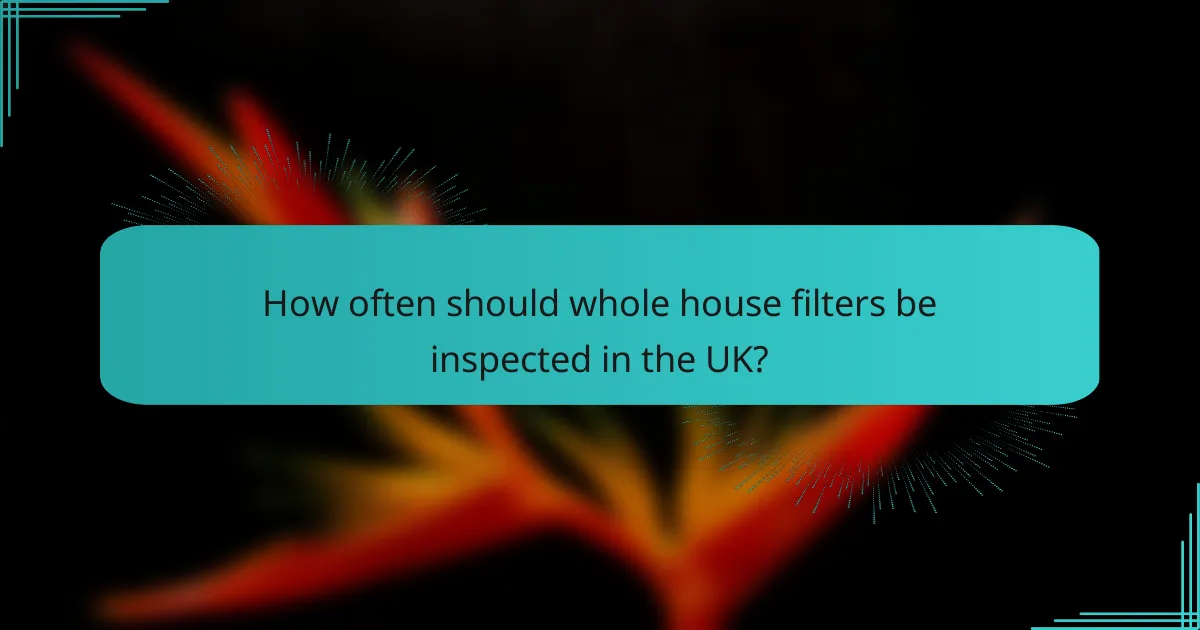
How often should whole house filters be inspected in the UK?
Whole house filters in the UK should ideally be inspected annually to ensure optimal performance and water quality. Regular inspections help identify potential issues early, maintaining the system’s efficiency and longevity.
Annual inspections recommended
Annual inspections are crucial for whole house filters to check for clogs, leaks, and overall system integrity. During these inspections, a professional can assess the condition of the filter cartridges and recommend replacements if necessary.
Scheduling these inspections at the same time each year can help homeowners remember and maintain a consistent routine. Consider aligning inspections with other home maintenance tasks for convenience.
Signs of wear to watch for
Homeowners should be vigilant for signs of wear in their whole house filter systems. Common indicators include reduced water pressure, unusual tastes or odors in the water, and visible sediment buildup in the filter housing.
If you notice any of these signs, it may be time for an inspection or cartridge replacement. Regular monitoring can prevent more significant issues and ensure that your water remains clean and safe for consumption.

What is the process for cartridge replacement?
The process for cartridge replacement involves removing the old filter cartridge from your whole house filtration system and installing a new one. Regular replacement ensures optimal water quality and system efficiency.
Frequency of cartridge replacement
Cartridge replacement frequency typically depends on water quality and usage. Generally, it is recommended to replace cartridges every 6 to 12 months. However, if you notice a decrease in water pressure or a change in taste or odor, it may be time for a replacement sooner.
For households with high water usage or those relying on well water, more frequent changes may be necessary. Monitoring your system’s performance can help determine the best schedule for your needs.
Steps for replacing cartridges
To replace the cartridges, first, turn off the water supply to the filtration system. Next, relieve any pressure by opening a faucet downstream. Once the pressure is released, remove the access panel or cover to reach the cartridges.
Carefully remove the old cartridge and dispose of it according to local regulations. Install the new cartridge, ensuring it is seated properly, then reassemble the system and turn the water supply back on. Finally, check for leaks and run water through the system for a few minutes to flush out any debris.
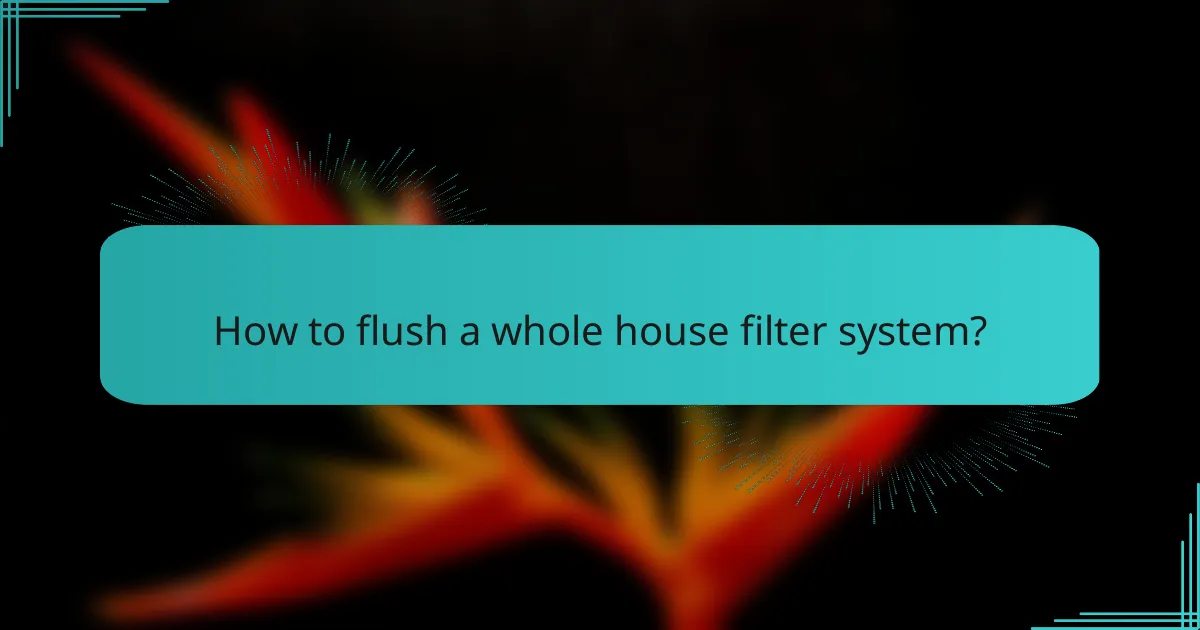
How to flush a whole house filter system?
Flushing a whole house filter system involves clearing out accumulated debris and contaminants to maintain optimal water quality. Regular flushing helps ensure that the system operates efficiently and prolongs the lifespan of the filters.
Flushing frequency
The frequency of flushing a whole house filter system typically depends on the water quality and usage. For most households, flushing every 6 to 12 months is advisable, but areas with high sediment levels may require more frequent maintenance. Monitoring water clarity and pressure can help determine the right schedule.
Step-by-step flushing procedure
To flush your whole house filter system, follow these steps: First, turn off the water supply to the system. Next, open the flush valve or drain valve to release the water and contaminants. Allow the system to drain completely before closing the valve.
After draining, turn the water supply back on slowly to refill the system. Monitor for any leaks and check the water clarity. If necessary, repeat the flushing process until the water runs clear. Always consult your manufacturer’s guidelines for specific instructions related to your filter model.

What are the costs associated with whole house filter maintenance?
The costs associated with whole house filter maintenance typically include inspection fees, replacement cartridge expenses, and system flushing charges. Understanding these costs can help homeowners budget effectively for maintaining clean water throughout their homes.
Inspection costs
Inspection costs for whole house filters can vary significantly based on location and service provider, generally ranging from $50 to $150 per visit. Regular inspections, typically recommended annually, help ensure the system is functioning properly and can identify potential issues before they escalate.
When scheduling an inspection, consider asking for a detailed report on the system’s performance and any necessary repairs. This proactive approach can save money in the long run by preventing costly replacements or extensive repairs.
Replacement cartridge costs
Replacement cartridge costs depend on the type of filter system in use, with prices usually falling between $30 and $100 per cartridge. It’s essential to replace cartridges according to the manufacturer’s recommendations, which is often every 6 to 12 months, to maintain optimal water quality.
Homeowners should compare cartridge options and consider bulk purchasing to save on costs. Additionally, some systems may have more affordable or longer-lasting alternatives, so researching compatible cartridges can be beneficial.

What should you consider when choosing a whole house filter?
When selecting a whole house filter, consider your specific water quality needs and ensure compatibility with your existing plumbing system. These factors will significantly influence the effectiveness and longevity of the filtration system.
Water quality needs
Understanding your water quality is crucial for choosing the right whole house filter. Start by testing your water for contaminants such as chlorine, sediment, heavy metals, and bacteria. Depending on the results, you may need a filter that targets specific impurities, such as activated carbon for chlorine or reverse osmosis for heavy metals.
For example, if your water has high levels of sediment, a sediment filter may be necessary as a pre-filter to protect other filtration systems. Regular water testing can help you adjust your filtration needs over time.
System compatibility
Ensure that the whole house filter you choose is compatible with your home’s plumbing system. Check the size of your pipes and the flow rate requirements of the filter to avoid installation issues. Most filters are designed for standard residential plumbing, but some may require additional fittings or modifications.
Additionally, consider the filter’s maintenance requirements, such as cartridge replacement frequency and system flushing. Some systems may require more frequent maintenance than others, impacting your long-term costs and convenience.
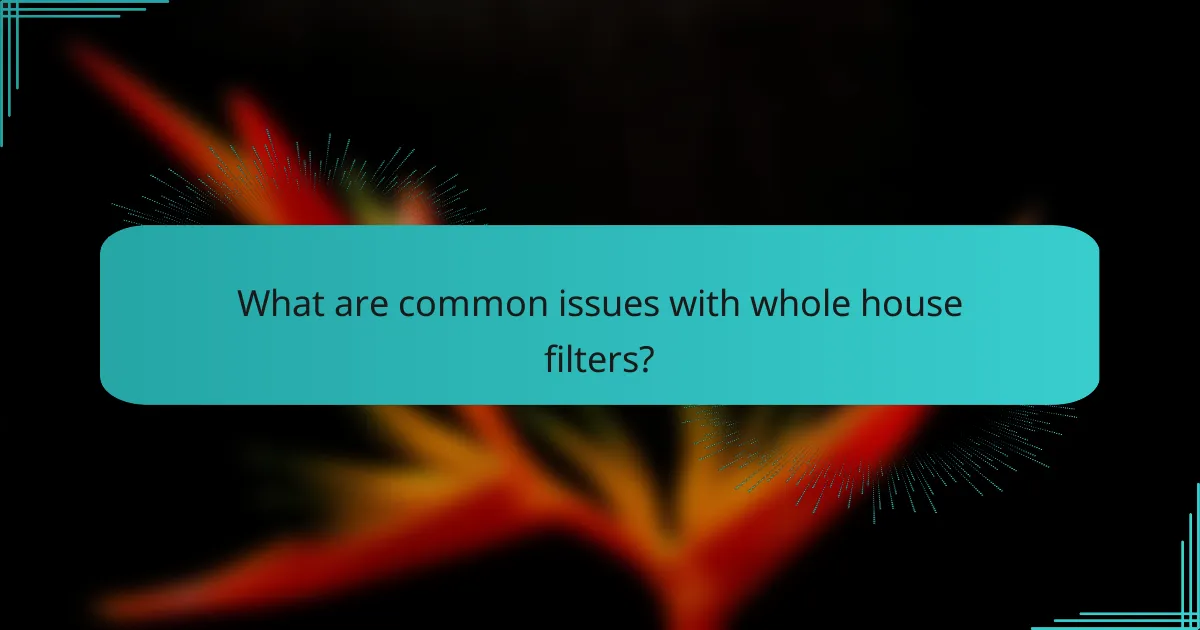
What are common issues with whole house filters?
Common issues with whole house filters include reduced water flow, unpleasant tastes or odors, and frequent clogging. These problems can arise from improper maintenance, such as neglecting annual inspections or failing to replace cartridges on time.
Annual inspections
Annual inspections are crucial for maintaining the efficiency of whole house filters. During an inspection, a technician checks for leaks, assesses filter performance, and ensures that all components are functioning correctly. Regular inspections help identify potential issues before they escalate, saving homeowners from costly repairs.
Homeowners should schedule these inspections at a consistent time each year, ideally before peak water usage seasons. Keeping a maintenance log can also help track inspection dates and any necessary repairs.
Cartridge replacement
Cartridge replacement is essential for the effective operation of whole house filters. Depending on water quality and usage, cartridges typically need replacing every 6 to 12 months. Signs that a cartridge needs replacement include decreased water pressure and visible discoloration.
To ensure optimal performance, always use cartridges that meet manufacturer specifications. It’s advisable to keep a few spare cartridges on hand to avoid interruptions in water filtration.
System flushing
System flushing involves running water through the filter system to remove accumulated sediment and contaminants. This process should be performed regularly, typically every few months, to maintain water quality and flow rate. Flushing can help prevent buildup that may lead to clogs or reduced efficiency.
To flush the system, turn off the water supply, open the flush valve, and allow water to run until it appears clear. Always refer to the manufacturer’s guidelines for specific flushing procedures and frequency recommendations.
